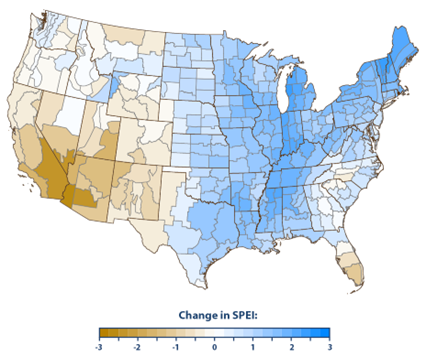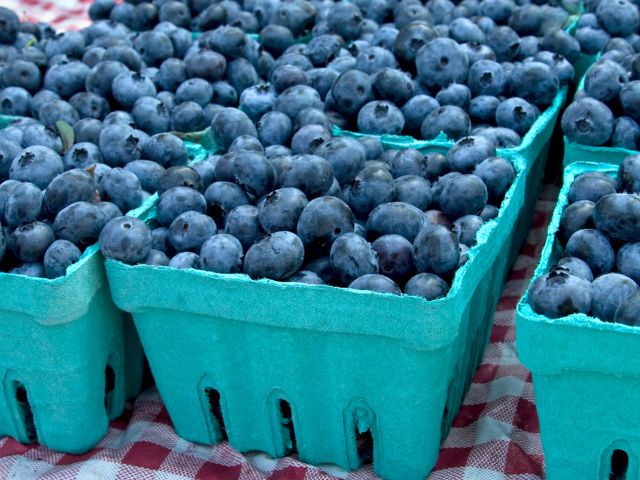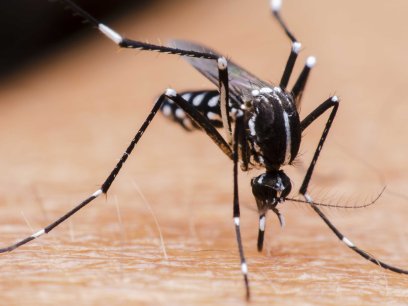
Do you have a farmers market in your neighborhood? According to the US Department of Agriculture, the popularity of local farmers markets in the United States has boomed, increasing from 1,755 total markets in 1994 to 8,771 in 2019.
This growth is good news for farmers and shoppers alike. Farmers markets increase a community’s access to fresh, nutritious food. Money spent at a farmers market stays in the local economy, often supporting beginning or small farmers.
“Buying local” decreases the distance that your food travels before it reaches you, reducing the environmental impact from the energy used during transportation. Enjoying fresh fruits and vegetables while they are in season tastes better and can save you money.
How a Changing Climate Impacts Crops
The types of fruits and vegetables that you can find at a farmers market varies widely by region and time of year. Weather and climate conditions play a big role in the production of summer produce, affecting the taste, size, and quantity of fruits and vegetables available during the warmer months. Climate change has the potential to impact food production in many ways, including:
- Lengthening the growing season, which can have a positive or negative impact depending on the type of crop.
- Disrupting the timing of pollination if plants bloom before pollinators like bees and butterflies arrive.
- Increasing the frequency of wildfires, which can destroy crops.
- Expanding the range of harmful insects, weeds, and plant diseases.
- Increasing health risks for agricultural workers due to extreme heat, degraded air quality, and increased pests.
Drought is one of the US Environmental Protection Agency’s key indicators of climate change. While the droughts of the 1930s Dust Bowl era remain the most extreme recorded in history, drought has become more common in recent years, particularly in the western United States. Between 2000-2020, roughly 20-70% of the US experienced abnormally dry conditions. Drought highlights the demand for water in food production and our daily lives.

What Produce is in Season?
Before visiting a farmers market, check what produce is in season. Below, learn about a few of the most popular fruits and vegetables, as well as how they are being impacted by a changing climate.

Blueberries
Often referred to as a “superfood,” blueberries are among the most-nutrient dense berries. Within the United States, cultivated blueberries predominantly come from Washington, Oregon, Georgia, Michigan, and California, with most of the wild production occurring in Maine.
In the fall and winter, blueberries require about 1,000 “chill hours,” or time with temperatures below 45°F but still above freezing. The berries themselves will not grow until this requirement has been fulfilled, so an unusually warm winter can throw berry season into disarray. Unusually cold, wet, and windy weather can also inhibit pollination.
Corn
A true summer staple, fresh sweet corn can be cut into individual kernels or eaten straight from the cob. It is a good source of vitamin C and fiber. Of the more than six billion pounds of sweet corn produced each year in the United States, the majority is grown in Florida, California, Georgia, Washington, and Minnesota.
This veggie needs lots of water. If a growing corn plant experiences water stress, or if the temperatures are high enough that too much moisture is being wicked out of the soil and the plants through evapotranspiration, fewer ears of corn may develop, and those that do emerge may be malformed.
Studies suggest that climate change will shift the Corn Belt—where most of the country’s corn is grown to feed livestock or for processed foods—from its current location in Illinois, Indiana, and Iowa north to Canada.
Lettuce
Romaine, arugula, Bibb, or frisée—there are seemingly endless options when it comes to lettuce. It is naturally free of fat, sodium, and cholesterol and rich in vitamins K, A, and folate. Lettuce is the most widely consumed leafy green in the US.
Production occurs year-round but shifts regionally depending on the time of year. Lettuce production relies on irrigation and a steady supply of water. Warmer spring and summer temperatures can lead to bolting, make the lettuce taste bitter, and bring additional pests and diseases. Scientists are working to adapt this cool-season crop to make it more heat-tolerant and pest-resistant.
Peaches
This summer favorite is packed with flavor, vitamins, and antioxidants. Like blueberries, peaches require a certain number of “chill hours” to bloom and enough heat to ripen the fruit. Rising temperatures decrease the amount and size of fruit that are produced. While Georgia is known as the peach state, it is actually not the top producer of peaches in the US—that title goes to California, which accounted for 56% of the country’s fresh peach crop in 2017.
While peaches are still important to Georgia’s state economy, 2023 has been a particularly rough year. The University of Georgia estimates that 90% of the peach crop has been destroyed due to a combination of an abnormally-warm winter and a late-season freeze. Researchers are identifying genes that could eventually help peach trees adapt to climate change.
Tomatoes
While tomatoes are produced in every US state, if you're buying fresh tomatoes at the grocery store , it's likely that they're coming from either Florida or California. Local tomatoes are available in farmers markets all across the country during the summer months.
Although these seasonal snacks come in many shapes, sizes, and colors, they all thrive at temperatures between 79-85°F during the day, and 65-70°F at night during their summer growing period. If there's a cold snap during these traditional warm months, or a scorcher that brings the average temperatures out of this range, the fruit set (the size of the fruit) and the taste and overall quality can be negatively impacted.
Tomato production is also expected to shift geographically due to warmer temperatures from climate change.
Farmers Market Tips
Ready to find a farmers market near you? Follow these tips for a successful shopping trip.
- Make a plan. Before you head to the farmers market, plan out your meals for the week using fruits and vegetables that are ripe during the summer growing season, so you know what you need and can minimize food waste.
- Check the weather. In times of inclement weather, dress accordingly and check the farmers market’s social media to make sure it isn’t canceled.
- Bring cash and a reusable shopping bag.
- Do a walkthrough of the farmers market before you start buying. Compare what each stand has to offer, the quality of their produce, and look for any deals on bulk items.
- Ask questions. Talk to the farmers about their products and don’t be afraid to ask questions about how their fruits and vegetables are grown or recipes that they recommend.


